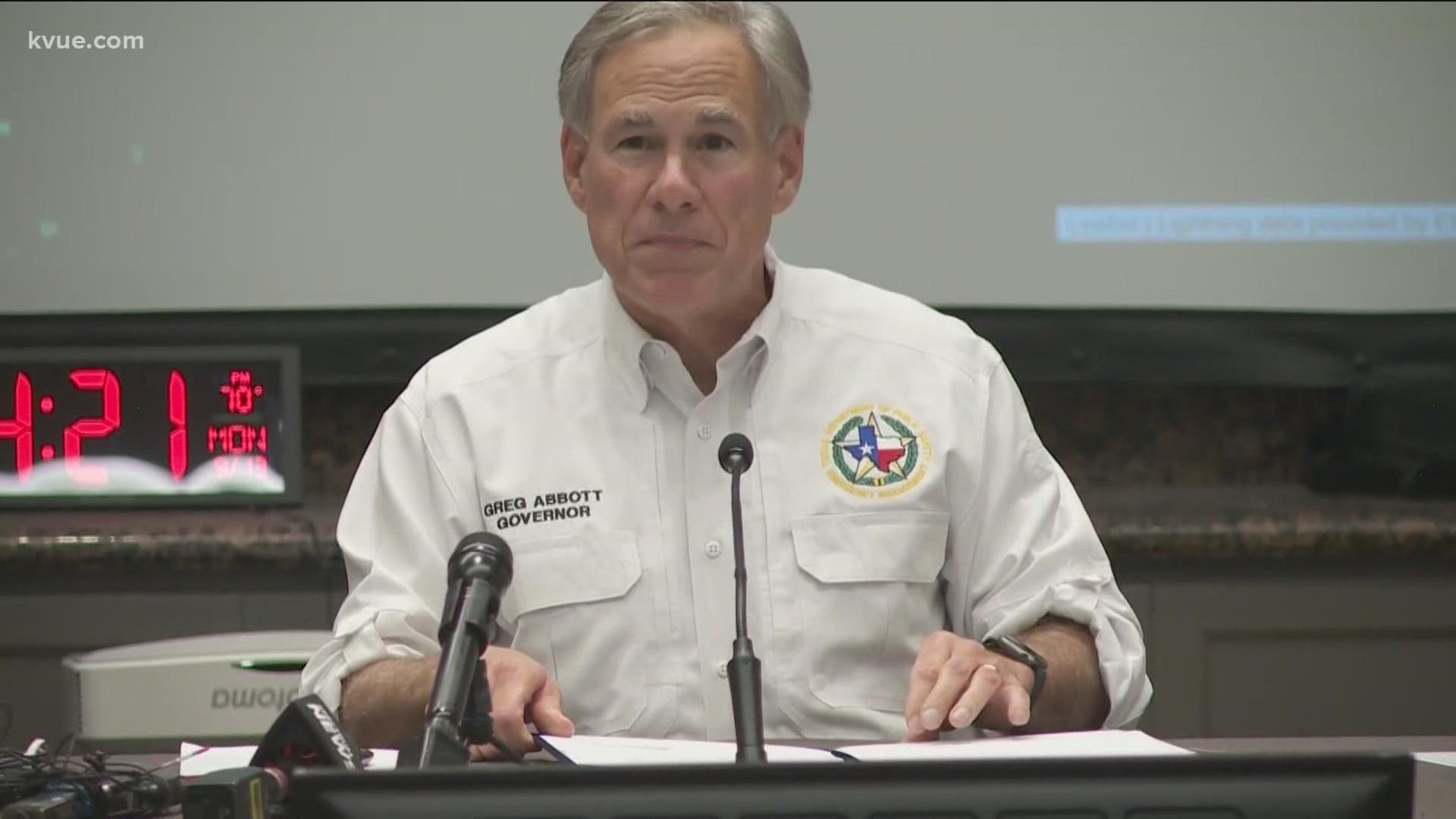AUSTIN, Texas — Texas Gov. Greg Abbott signed a proclamation for a disaster declaration in response to then-Tropical Storm Nicholas at a press conference Monday. Three cities and 17 counties were included in the original declaration.
The counties include Aransas, Brazoria, Calhoun, Chambers, Galveston, Harris, Jackson, Jasper, Jefferson, Matagorda, Montgomery, Newton, Nueces, Orange, Refugio, San Patricio and Victoria. On Tuesday, Abbott added Liberty and Wharton counties.
Also on Tuesday, Abbott temporarily waived the limit on commercial drivers' hours of service and the oversize and overweight permitting requirements.
Gov. Abbott was joined by Texas Division of Emergency Management Chief Nim Kidd at the Alternate State Operations Center in Austin.
"Texas is ready to respond," Abbott said.
On Sunday, Abbott ordered the Texas State Operations Center to increase its readiness to Level II (escalated response), which was to begin Monday morning at 9 a.m. The SOC is now operating at Level II to help coordinate the State's response in support of local officials across Texas.
Nicholas is expected to bring heavy rainfall and potential flooding to the entire Gulf Coast as it moves slowly across Texas. Abbott said Monday that the storm "will not pose a threat" to the state's power grid.
"There are no significant outages reported at this time," Abbott said at the press conference.
On Sunday, Abbott urged all Texans to begin preparing immediately and pay close attention to local forecasts.
"The State Operations Center has increased its readiness and is prepared to assist local officials in their response to Tropical Storm Nicholas," said Gov. Abbott on Sunday. "As this storm approaches Texas, I urge our Southeast Texas and Gulf Coast communities to prepare now to protect themselves and their loved ones from the severe weather conditions that Tropical Storm Nicholas will bring."
The following resources have been readied to aid local communities:
- Texas A&M Engineering Extension Service (Texas A&M Task Force One): 6 Swift Water Rescue Boat Squads and 8 Overhead Packages.
- Texas Parks and Wildlife Department: Game Warden Boat Teams.
- Texas Military Department: 5 Ground Transportation Platoons With High Profile Vehicles.
- Texas Department of State Health Services: Texas Emergency Medical Task Force (EMTF) Severe Weather Packages.
And the following actions and resources have been lined up for potential activation if needed:
- Texas A&M Forest Service: Saw Crews and Incident Management Teams.
- Texas Department of Transportation: Monitoring Road Conditions And Prepositioned Water-Filled Barriers.
- Texas Department of Public Safety: Texas Highway Patrol Search And Rescue Aircraft and The Tactical Marine Unit.
- Public Utility Commission: Power Outage Monitoring And Coordination With Utility Providers.
The governor's office also provided the following hurricane safety tips:
- Know types of flood risk in your area. Visit FEMA’s Flood Map Service Center for information here: https://msc.fema.gov/portal/home
- Sign up for your community’s warning system. The Emergency Alert System (EAS) and National Oceanic and Atmospheric Administration (NOAA) Weather Radio also provide emergency alerts.
- Build an emergency supply kit. For more information on how to build a kit, visit: https://www.ready.gov/kit
- Keep important documents in a waterproof container. Create password-protected digital copies.
- Protect your property. Move valuables to higher levels. Declutter drains and gutters. Install check valves. Consider a sump pump with a battery.
- Be extremely cautious of any water on roads or in creeks, streams, storm drains, or other areas – never attempt to cross flowing streams or drive across flooded roadways and always observe road barricades placed for your protection. Remember, "Turn Around Don’t Drown."
The Electric Reliability Council of Texas (ERCOT) also released a statement Monday saying it is preparing the grid to maintain reliability during the storm:
"In addition to officially alerting ERCOT market participants of the weather threat, ERCOT has acted to reduce planned maintenance-related outages in the area most likely to be affected by Nicholas and instructed power companies to implement their emergency procedures in preparation for the storm.
"Any power outages caused by the storm will most likely be at the local distribution level. Local outages can be caused by factors ranging from high winds toppling power poles to tree limbs falling on power lines.
"Residents and businesses experiencing power outages should contact their local electric service providers to report those outages and receive updates on restoration times."
Texans impacted by Hurricane Nicholas can now complete a Self Reporting Damage Survey to help the state identify damages to private homes and businesses and to assist emergency management officials to assess the damages that occurred.
PEOPLE ARE ALSO READING:

